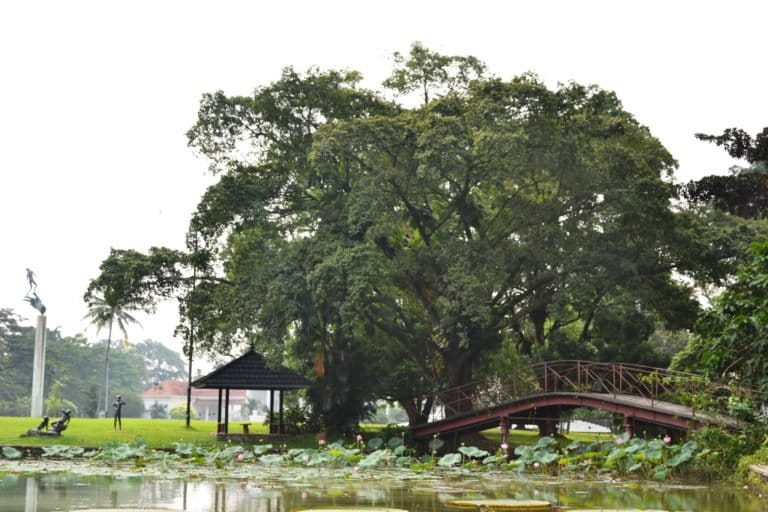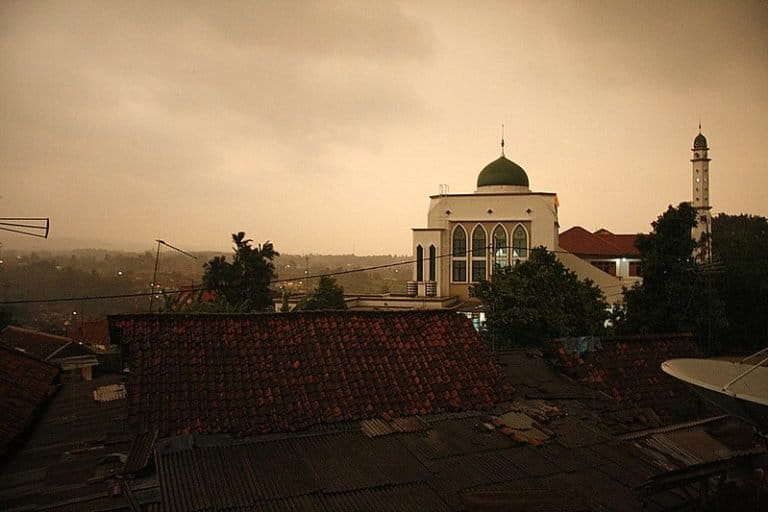Light exhibits at Indonesian botanic garden spark commercialization concerns
Oct 19, 2021
- Established by the Dutch colonial government in the late 19th century, Indonesia’s Bogor Botanical Gardens is one of the oldest and largest in the world.
- As one of the nation’s most important scientific institutions, its formal functions are plant conservation, research, education, scientific tourism, and environmental services.
- To attract a wider range of visitors, decorative lighting installations and projections on trees have been installed as part of a new after-dark attraction.
- Several groups have criticized the lighting exhibits, including four former heads of the garden, who say they commercialize the site and detract from its scientific and educational mission in favor of profit and recreation.
An hour’s drive south of the Indonesian capital, Jakarta, set against the backdrop of the volcanic Mount Salak, lies Bogor, whose frequent rainfall — even during the dry season — has earned it the nickname “Kota Hujan” (Rainy City). In 1817, the Dutch colonial government decided this lush and fertile location was ideal for an experimental garden for crops such as coffee, tea, oil palm and the quinine-producing cinchona tree to be introduced to the then-Dutch East Indies.
After Indonesia declared independence in 1945, the new government developed the site into a botanical garden, heralding the birth of organized botany in the young nation along with several other scientific institutions. Two centuries after its creation, covering an area of 87 hectares (215 acres) and containing more than 15,000 species of trees, 300 orchid varieties and 5,359 other plant species, Kebun Raya Bogor, the Bogor Botanical Gardens, is one of the oldest and largest in the world.
Earlier this year, the garden’s managing body, the National Research and Innovation Agency (BRIN), in collaboration with private management company PT Mitra Natura Raya, installed an after-dark attraction at the garden, dubbed GLOW.
With the backing of two of Indonesia’s biggest banks, it features decorative lighting exhibits and lighting projections on trees accompanied by music and narration. GLOW will “stimulate visitors’ imaginations with fictional stories of nocturnal plants and animals,” according to its website. Other features include an illuminated ornamental waterwheel, water fountains, floating lights, selfie spots, and two large gates bearing the bank partners’ logos.
Fearing that GLOW will commercialize the garden and detract from the institution’s scientific and educational mission in favor of profit and social media-driven recreation, various groups have spoken out against the new attraction. The critics include four of the garden’s former heads, academics from the Bogor Institute of Agriculture (IPB), which is one of Indonesia’s premier institutions of higher learning, and a civil society group.

In an open letter circulating on social media, the four former heads — Made Sri Prana (who managed the botanic garden from 1981 to 1983), Usep Soetisna Suhirman (1990-1887), Dedy Darnaedi (1997-2003) and Irawati (2003-2008) — called on the current leadership to maintain it in accordance with its five duties and functions: plant conservation, research, education, scientific tourism, and environmental services. They also asked them to prioritize a scientific approach and pay attention to conservation and environmental issues.
“Even when conducting fundraising business activities, botanical gardens should not be dazzled by instantaneous profits, and should always choose green businesses that are environmentally friendly,” they wrote.
They noted that, as mandated by a presidential regulation, entrance tickets to the garden are inexpensive compared to other public places because it’s not a recreation site. The relatively low price is intended to make entry affordable for the wider community, and therefore to spread the messages of conservation, education and environmental stewardship to a wider swath of society.
The former heads also expressed concern that GLOW visitors could disturb the silence of the garden at night, and that the lights could interfere with the nocturnal lives of pollinating animals and insects.
Finally, they voiced their opposition to the construction of new concrete footpaths that reduce water absorption, a departure from the garden’s river stone footpaths that allow water to seep into the earth. The regulations governing the management of the garden stipulate that no more than 20% of the total area may be developed, and the former heads say the construction of the concrete footpaths will exceed this limit.
Pressure from within
In a webinar conducted by IPB and the IPB Landscape Architecture Alumni Family Gathering Forum, Melani Abdulkadir, a lecturer at IPB’s Department of Communication Science and Community Development, said the new installations would put pressure on the Bogor Botanical Gardens.
“The Bogor Botanical Gardens is an ecosystem that has been developed over more than 200 years, during which it has withstood external and internal pressures,” she said. “The new installations are certainly the result of pressure from within, and I’m afraid they will be like the straw that broke the camel’s back.”
Melani emphasized that the relationship between “human systems” and “ecological systems” is increasingly exploitative. She acknowledged that although the garden isn’t a natural forest but rather the result of human intervention, its five main functions should not be abandoned.
“The authenticity of the Bogor Botanical Gardens must be maintained,” she said. “These botanical gardens should not be seen as a recreational park, but one with historical value and strategic functions that are important for the environment and society.”

In defense of the new attraction, BRIN chief Laksana Tri Handoko said commercial activities such as cafes, guesthouses, hotels and photography businesses have been operating inside the garden for a long time.
“Currently all commercial activities are managed by partners with clear business relationships so that state revenues are optimized,” he said in a statement. “The management is transparent and accountable with regard to this matter.”
Handoko said the garden has three management bodies for its various functions: the Botanical Gardens Plant Conservation Research Center for research units and researchers; the Deputy for Infrastructure through BRIN’s Directorate of Laboratory and Science and Technology for research laboratories; and the Deputy for Infrastructure through the Directorate of Collections for collection maintenance.
“This division of managers ensures that researchers and research units can focus on conducting research without being burdened by overall infrastructure management,” he said, adding the garden’s five main functions “require innovation so that their benefits are optimally felt by the public.”
Yan Rianto, BRIN’s acting deputy for infrastructure research and innovation, said the Bogor Botanical Gardens’ education and tourism functions would showcase innovations to encourage visits.
“GLOW’s innovative program is inspired by various botanical gardens abroad that hold night tours,” he said. “Some countries already have these types of programs. GLOW is currently only held on weekends, and in the future will only operate a maximum of four times a week.”

Bogor Mayor Bima Arya said in a statement published on the city’s official website that his administration had agreed that the garden’s management would develop the area guided by conservation principles, which are separate from tourism. To address concerns about the garden’s commercialization, he requested the GLOW concept be studied by personnel from both IPB and BRIN, adding that “all parties must have data.”
Bima also ordered the municipal environmental agency to coordinate with BRIN and IPB, adding that whatever the outcome, his administration would continue to communicate with PT Mitra Natura Raya, the contractor, which manages three other botanical gardens in Indonesia.
In the same statement, the company’s board chairman, Ery Erlangga, said it prioritizes conservation and will maintain the Bogor Botanical Gardens in order for it to one day potentially receive UNESCO World Heritage status. The bid for a UNESCO listing was initiated by various groups in 2013.

Various petitions calling for the suspension of GLOW on Change.org have received thousands of signatures.
“The GLOW tour snatches away the night, which is the right of all living things within a botanical garden ecosystem. At night plants and animals partially rest and regain energy, hunt, interact and reproduce,” says one of them, launched by a group calling itself the Care for the Bogor Botanical Gardens Community.
Like the former garden heads, community member Satyawan Sunito said he’s also concerned that artificial light at night could potentially disrupt the garden’s ecosystem, and that GLOW could jeopardize the garden’s bid for UNESCO World Heritage status.
Earth ethics
IPB professor Siti Nurisyah, who received the 2021 IPB School of Agriculture Lifetime Achievement Award, said in the webinar that the Bogor Botanical Gardens should be mapped to identify sensitive areas and determine which ones should be restricted to visitors and which could host environmentally friendly activities. The mapping should be conducted by experts and consider ecological, sociocultural, terrain, and regulatory aspects, she said.

In the same webinar, Hadi S. Alikodra, professor of nature conservation and wildlife development at IPB, said a joint effort by academics, businesspeople and the government was needed to build a knowledge-based economy. The aim is to produce decisions that maintain the sustainability of the Bogor Botanical Gardens while avoiding damaging commercial activities.
He discussed the need for an environmental movement based on an “ecosophy” approach. A portmanteau of ecological philosophy, it’s a philosophy of ecological harmony emphasizing that human beings should constantly study, research, understand and appreciate nature or their environment.
“Conserving nature must be done carefully,” Hadi said. “Remember, biodiversity is the foundation of human life now and in the future, and we must preserve it.”
To achieve this, humans must behave ethically toward the environment, he said. “The old ways that are not friendly, which result in the destruction of nature, must be abandoned.”
This story was reported by Mongabay’s Indonesian team and first published here on our Indonesian site on Oct. 4, 2021.
Banner: Flowers in the Bogor Botanical Gardens. Image by Nick Botter/Flickr.
FEEDBACK: Use this form to send a message to the author of this post. If you want to post a public comment, you can do that at the bottom of the page.